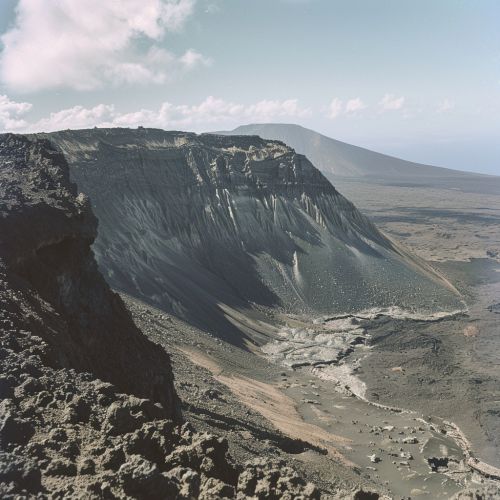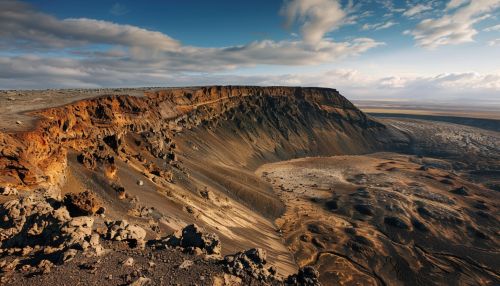Cinder cones: Difference between revisions
(Created page with "== Introduction == Cinder cones, also known as scoria cones, are the simplest type of volcano. They are built from particles and blobs of congealed lava ejected from a single vent. As the gas-charged lava is blown violently into the air, it breaks into small fragments that solidify and fall as cinders around the vent to form a circular or oval cone. These cones are typically steep-sided and have a crater at the summit. == Formation and Structure == Cinder cones form t...") |
No edit summary |
||
| Line 19: | Line 19: | ||
At the summit of a cinder cone, a crater is often present. This crater forms as the vent ejects material during the eruption. The size and shape of the crater can vary depending on the eruption's intensity and duration. | At the summit of a cinder cone, a crater is often present. This crater forms as the vent ejects material during the eruption. The size and shape of the crater can vary depending on the eruption's intensity and duration. | ||
[[Image:Detail-79717.jpg|thumb|center|A steep-sided cinder cone volcano with a crater at the summit, surrounded by a barren landscape.|class=only_on_mobile]] | |||
[[Image:Detail-79718.jpg|thumb|center|A steep-sided cinder cone volcano with a crater at the summit, surrounded by a barren landscape.|class=only_on_desktop]] | |||
== Distribution and Examples == | == Distribution and Examples == | ||
Latest revision as of 21:28, 19 May 2024
Introduction
Cinder cones, also known as scoria cones, are the simplest type of volcano. They are built from particles and blobs of congealed lava ejected from a single vent. As the gas-charged lava is blown violently into the air, it breaks into small fragments that solidify and fall as cinders around the vent to form a circular or oval cone. These cones are typically steep-sided and have a crater at the summit.
Formation and Structure
Cinder cones form through the accumulation of volcanic debris around a vent. The primary material that constitutes a cinder cone is scoria, a highly vesicular, dark-colored volcanic rock. The formation process involves several stages:
Eruption Dynamics
The eruption of a cinder cone begins with the release of gas-charged magma from a central vent. The high gas content causes the magma to fragment into small pieces, which are then ejected into the air. Upon cooling, these fragments solidify into cinders or scoria. The ejected material falls back to Earth, accumulating around the vent and forming a cone-shaped hill.
Cone Composition
Cinder cones are primarily composed of basaltic to andesitic lava, which is rich in iron and magnesium. The cinders are typically porous and lightweight due to the high gas content. The size of the cinders can vary, but they are generally small, ranging from a few millimeters to several centimeters in diameter.
Crater Formation
At the summit of a cinder cone, a crater is often present. This crater forms as the vent ejects material during the eruption. The size and shape of the crater can vary depending on the eruption's intensity and duration.


Distribution and Examples
Cinder cones are found in volcanic regions worldwide. They are particularly common in areas with basaltic volcanism. Some notable examples include:
Parícutin
Parícutin, located in Mexico, is one of the most famous cinder cones. It erupted in 1943 and continued for nine years, growing to a height of 424 meters. The eruption provided valuable insights into the formation and growth of cinder cones.
Sunset Crater
Sunset Crater in Arizona, USA, is another well-known cinder cone. It erupted around 1085 AD and is part of the San Francisco Volcanic Field. The cone stands approximately 300 meters high and is surrounded by lava flows and other volcanic features.
Mount Etna
Mount Etna in Italy hosts numerous cinder cones on its flanks. These cones are the result of flank eruptions and contribute to the complex volcanic landscape of Etna.
Geological Significance
Cinder cones provide important information about volcanic processes and the Earth's interior. Their study helps geologists understand the dynamics of volcanic eruptions, magma composition, and the behavior of volcanic gases.
Eruption Styles
Cinder cones typically exhibit Strombolian eruptions, characterized by moderate explosivity and the ejection of incandescent cinders. These eruptions are driven by the release of volcanic gases, which fragment the magma into small pieces.
Magma Composition
The composition of the magma that forms cinder cones is usually basaltic to andesitic. This composition reflects the partial melting of the Earth's mantle and the ascent of magma through the crust. The study of cinder cone lavas provides insights into mantle processes and magma generation.
Volcanic Hazards
While cinder cones are generally less hazardous than other types of volcanoes, they can still pose risks. The primary hazards associated with cinder cones include lava flows, ashfall, and pyroclastic surges. Understanding these hazards is crucial for mitigating risks in volcanic regions.
Environmental Impact
The formation of cinder cones can significantly impact the surrounding environment. The deposition of volcanic material can alter landscapes, create new habitats, and affect ecosystems.
Soil Formation
The weathering of cinders and lava flows contributes to soil formation. These volcanic soils are often rich in minerals and can support diverse plant communities. Over time, the colonization of plants and the accumulation of organic matter enhance soil fertility.
Ecosystem Development
Cinder cones and their associated lava flows create unique habitats for various plant and animal species. The harsh conditions of the volcanic landscape can lead to the development of specialized and resilient ecosystems.
Human Interaction
Cinder cones have been both a challenge and a resource for human societies. Their eruptions can disrupt communities, but they also offer opportunities for scientific research, tourism, and resource extraction.
Volcanic Monitoring
Monitoring cinder cones is essential for predicting eruptions and mitigating volcanic hazards. Techniques such as seismology, gas measurements, and remote sensing are used to track volcanic activity and provide early warnings.
Tourism and Recreation
Cinder cones are popular destinations for tourists and outdoor enthusiasts. Their unique landscapes and geological features attract visitors interested in hiking, photography, and studying volcanic processes.
Resource Extraction
Cinder cones can be sources of valuable volcanic materials, such as scoria and pumice. These materials are used in construction, landscaping, and industrial applications. However, resource extraction must be managed to minimize environmental impact.
